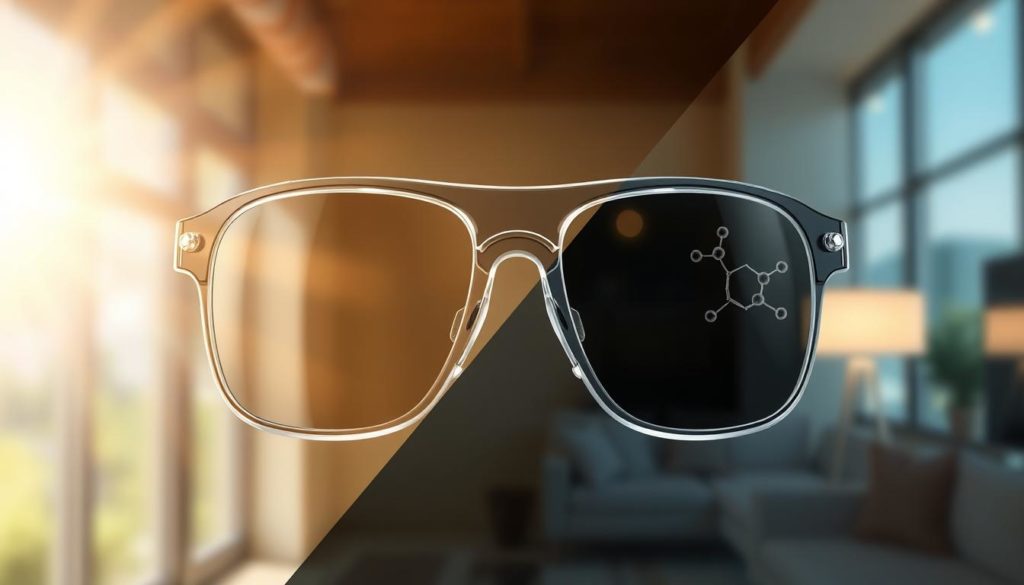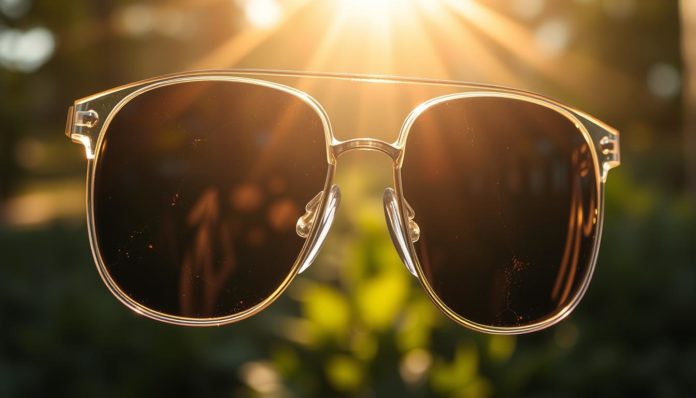Did you know about 80% of people who wear glasses don’t know about photochromic lenses? They’re becoming more popular as people look for easy, all-in-one eyewear. These lenses change color with the light, making them comfortable and protective without needing to switch glasses.
Exploring photochromic lenses can open up new possibilities, especially for those who move between indoors and outdoors a lot. They block harmful UV rays and cut down glare, making your eyes more comfortable. The tech behind these lenses has improved a lot, making them a favorite for versatile eyewear.
Join us as we dive into the world of photochromic lenses. We’ll cover their history, benefits, and the different types out there. You’ll see why these lenses might be the ideal choice for your eyewear needs.
What Are Photochromic Lenses?

Photochromic lenses change color when they get light, especially UV light. They get darker in sunlight and clear when it’s dimmer. This makes them great for moving between indoors and outdoors without needing to switch glasses.
Definition of Photochromic Lenses
Photochromic lenses change color based on the light around them. They have special molecules that darken when hit by UV light. When UV light goes away, these molecules return to their original state, making the lenses clear again.
History and Development
The idea of photochromic lenses started in the 1960s. The first ones, called “Photogray” lenses, came out in the 1960s. They used silver chloride.
Later, in the 1990s, new molecules made these lenses lighter and better. Now, you can find photochromic lenses in plastic and polycarbonate. This gives people more choices for their glasses.
How Photochromic Lenses Work
Photochromic lenses are a big step forward in eyewear. They change with sunlight, giving you the best vision and protection. Let’s explore how photochromic lenses work through their chemistry and materials.
The Science Behind the Transition
When hit by UV light, photochromic lenses change color. This happens because of silver halides or organic molecules inside the lens. These molecules absorb light and darken the lenses when exposed to UV.
When UV light goes away, the molecules go back to normal. This makes the lenses clear again.
Materials Used in Photochromic Lenses
The right photochromic lens materials are key for their quality and life span. Most lenses are made from polycarbonate or Trivex. These are light and strong.
The photochromic magic happens inside the lens or as a special coating. Even glass lenses can be made to change color with silver halide crystals.
Types of Light That Activate the Lenses
UV light is the main trigger for photochromic lenses. They react to UV from the sun and artificial sources. Visible light also plays a part, but UV is the main driver.
This selective response means the lenses work well in different light situations. They don’t change color too much indoors under artificial light.

Benefits of Photochromic Lenses
Photochromic lenses have many advantages that make them a favorite among many. They are convenient because you don’t need to switch between glasses and sunglasses. The lenses change color with the light, making it easy to go from indoors to outdoors without hassle.
Another big plus is the UV protection they offer. These lenses block 100% of harmful UV rays, keeping your eyes safe. This is especially important when you’re outside in the sun, making them great for outdoor activities.
They also help reduce eye strain, making them comfortable to wear. They adjust to light changes, ensuring your eyes get the right amount of light. This is great for people who move between indoors and outdoors often.
In summary, photochromic lenses are both practical and comfortable in different lighting. They’re perfect for driving, reading, or just enjoying the outdoors. They offer convenience, protection, and comfort all in one.
Different Types of Photochromic Lenses
Choosing the right photochromic lenses is key. Let’s explore the three main types: standard, blue light blocking, and polarized lenses.
Standard Photochromic Lenses
Standard photochromic lenses, or transition lenses, darken in UV light and clear indoors. They offer good sun protection for daily activities. They’re great for those who go in and out of the sun often.
Blue Light Blocking Photochromic Lenses
Blue light blocking lenses adjust to light changes and block harmful blue light from screens. They’re perfect for those who use computers, phones, or tablets a lot. They reduce eye strain and improve comfort.
Polarized Photochromic Lenses
Polarized lenses offer both polarization and light adaptation. They cut down glare from water, snow, and roads. This makes them great for driving, water sports, and outdoor fun. They enhance contrast and clarity in different lights.
Each lens type has its own benefits, fitting different needs and lifestyles. Whether for everyday use, screen time, or outdoor fun, there’s a lens for you.
Popular Brands and Their Offerings
When looking for the best photochromic lenses, knowing the top brands is key. This section covers some of the best in the market. It also compares costs to help you decide.
Top Brands in the Market
Several well-known brands offer high-quality photochromic lenses:
- Transitions: Known for quick light changes and many frame styles.
- Essilor: A top name in optics, offering photochromic lenses like Crizal. They’re clear and protect from UV rays.
- Hoya: Their lenses are comfy and block harmful light rays with advanced tech.
- Zeiss: Famous for clear and consistent color in their photochromic lenses.
Cost Comparison
Knowing the cost of photochromic lenses helps you pick within your budget. Here’s a table comparing popular brands’ prices:
| Brand | Average Cost | Unique Features |
|---|---|---|
| Transitions | $100 – $200 | Quick transition speed, wide range of compatible frames |
| Essilor Crizal | $150 – $250 | Excellent clarity, superior UV protection |
| Hoya | $120 – $220 | Advanced technology, superior comfort |
| Zeiss | $130 – $240 | Precision optics, consistent color |
Compatibility with Different Frame Styles
Choosing the right photochromic lenses for your glasses is key. Lens and frame compatibility matters for both looks and function. The right pair can improve your vision and match your style.
Frame styles like rimless, semi-rimless, and full-frame affect how your glasses look and work. Rimless frames are light and simple, letting the lenses shine. Full-frame styles are sturdy, great for active people or those needing durable glasses.
The material of your frames also matters. Titanium, acetate, or plastic frames offer different benefits. Titanium frames are strong and light, perfect for photochromic lenses.
Knowing about lens and frame compatibility helps you choose wisely. Think about both the frame style and material. This way, you get glasses that are good for your eyes and look great too.
Here’s a quick guide to help you understand the compatibility between various frame types and photochromic lenses:
| Frame Type | Benefits | Considerations |
|---|---|---|
| Rimless | Lightweight, minimalistic look | Less durable, lenses are more exposed |
| Semi-rimless | Balanced appearance, moderate support | Exposure of lenses edge, medium durability |
| Full-frame | Enhanced support, various styles | Heavier, may limit lens size options |
Your choice of photochromic lenses should fit your lifestyle and style. By considering lens and frame compatibility, you ensure your lenses work well and look good on you.
Photochromic Lenses for Glasses vs. Sunglasses
Choosing between glasses with light-adaptive lenses and photochromic lenses for sunglasses can greatly affect your vision. Knowing their special features and benefits helps you pick the best option for you.
Photochromic lenses for sunglasses are made for outdoor use. They change tint with UV light, offering great protection and reducing glare. They’re perfect for those who spend lots of time outside, like drivers, hikers, or cyclists.
Glasses with light-adaptive lenses work well indoors and outdoors. They switch from clear to tinted easily, fitting different light conditions. They’re great for people who want one pair of glasses for all lighting situations, without needing to change.
| Feature | Photochromic Lenses for Sunglasses | Glasses with Light-Adaptive Lenses |
|---|---|---|
| Best For | Outdoor Activities | Everyday Use |
| Transition Speed | Faster Outdoors | Moderate Indoors and Outdoors |
| UV Protection | High | Variable |
| Convenience | Specific to Sunglasses | All-in-One Solution |
The choice between photochromic lenses for sunglasses and glasses with light-adaptive lenses depends on your lifestyle and needs. Each type has its own benefits for better vision and eye health.
Understanding Photochromic Lenses
Photochromic lenses can be confusing. This section aims to clear up common misconceptions and give tips on caring for them.
Common Misconceptions
Many people think photochromic lenses change color instantly. But, they actually take a few moments to adjust to different light. Another myth is that they don’t work in cars. While most windshields block UV light, some new lenses work with visible light too.
Care and Maintenance Tips
Proper care can make your photochromic lenses last longer. Here are some important tips:
- Always use a microfiber cloth to clean your lenses to avoid scratching them.
- Regularly rinse your lenses with lukewarm water before wiping them to remove dust particles.
- Avoid exposing your lenses to extreme temperatures, as this can impair their photochromic properties.
- Store your glasses in a hard case when not in use to protect them from physical damage.
By taking good care of your photochromic lenses, they will keep providing great vision correction and protection for years.
User Reviews and Experiences
User reviews show how good photochromic lenses really are. Many people have shared their stories. They talk about how these lenses change their daily life, showing both good and bad points.
One person loved how easy photochromic lenses are to use outdoors. They change from clear to dark as the sun changes. This was great for runners and cyclists who didn’t have to switch glasses.
But, some users said it takes too long for the lenses to go back to clear inside. Even so, most say the latest versions are better. Still, it’s a small problem for a few.
A big point in many reviews is how these lenses reduce eye strain and glare. People who work on computers or are under bright lights found them very helpful. The blue light blocking feature made a big difference.
Overall, reviews highlight the benefits and some challenges of photochromic lenses. They show how these lenses make a big difference in daily life, whether it’s outdoors or at work.
FAQ
What are photochromic lenses?
Photochromic lenses darken when they get UV light and clear up when it goes away. They are also known as light-adaptive or transitional lenses.
How do photochromic lenses work?
These lenses have special molecules that change when they get UV light. This change darkens the lens. When the UV light goes away, the molecules change back, and the lens clears up.
What are the benefits of using photochromic lenses?
They are handy because you don’t need separate sunglasses. They also protect your eyes from UV rays and reduce eye strain. This makes them great for many activities and places.
What types of photochromic lenses are available?
You can find different types like standard, blue light blocking, and polarized lenses. Polarized lenses are good for driving and water sports because they cut down glare.
Which brands offer the best photochromic lenses?
Top brands include Transition Optical, Hoya, and ZEISS. Each has its own features and prices. You can pick based on what you need and how much you want to spend.
Are photochromic lenses compatible with all types of glasses frames?
Yes, they work with many frame styles. Think about the lens shape, frame material, and what you like to choose the right one.
How do photochromic lenses for glasses compare with photochromic lenses for sunglasses?
Both types adapt to light, but sunglasses are darker for more sun protection. Choose based on your outdoor plans.
What are some common misconceptions about photochromic lenses?
Some think they don’t work in cars (they do, but less because of windshields) and that they change color instantly (it takes a bit).
How should I care for and maintain my photochromic lenses?
Clean them gently with a microfiber cloth and lens cleaner. Stay away from harsh chemicals and heat. This keeps them working well for a long time.
What do users say about their experiences with photochromic lenses?
People like how convenient and comfortable they are. They enjoy not needing separate sunglasses and the UV protection. Some mention they like how they adjust to light changes.


